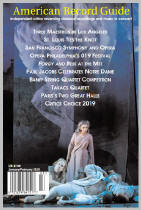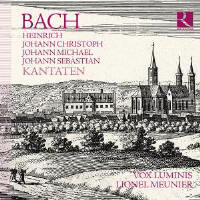Texte paru dans: / Appeared in: |
|
|
Outil de traduction ~ (Très approximatif) |
|
|
Reviewer: William
J. Gatens
This recording presents six
works by three members of the extended Bach family earlier than JS Bach plus
his Cantata 4 (Christ Lag in Todesbanden), very likely the earliest of his
surviving church cantatas. The pieces by Heinrich Bach (1615-92), Johann
Michael Bach (1648-94), and Johann Christoph Bach (1642-1703) can be better
described as sacred concertos than cantatas. They are works for voices with
obbligato instruments organized as a succession of short sections rather
than freestanding movements. Lionel Meunier and Vox Luminis have already
recorded a program of motets by ancestors of JS Bach. The difference is that
instruments may double the voices but have no independent material. The
present recording forms a natural sequel to the first. The earliest work
here is Ich Danke dir Gott by Heinrich Bach, his only surviving vocal
composition. Apart from it, all that survives of his output are an organ
chorale and two instrumental sonatas. We have more music by two of his sons:
Johann Michael Bach and Johann Christoph Bach. This program has two sacred
concertos by Johann
Michael: Ach Bleib bei Uns, Herr Jesu Christ and Herr, der König Freuet
Sich. JS Bach had an
especially high regard for his distant elder cousin Johann Christoph Bach,
calling him a “profound composer”. He presented several of his works in
Leipzig. He is represented
here by three pieces: Die Furcht des Herren, Herr, Wende Dich und Sei Mir
Gnädig, and Es Erhub Sich Ein Streit.
The first of these was written
for an installation of the Eisenach city Council. One soloist allegorically
is wisdom, and others represent elder and younger members of the council. Es
Erhub sich ein Streit is an exuberant work for the feast of St
JS Bach’s Cantata 4 is essentially a set of variations on an Easter chorale. Annotator Jerome Lejeune points out its similarity to a work by Johann Pachelbel based on the same chorale, suggesting that Bach took that piece as his model. Among the surviving elements of older compositional practice is the fivepart string writing (2 violins, 2 violas, and continuo bass), but it is a multi-movement work of more extensive scope than any of the other pieces here. The pieces by the elder composers are rarities that illustrate the style of Lutheran sacred vocal composition in the later 17th Century. They are all estimable works that are worth hearing, but I would stop short of calling them unjustly neglected masterpieces. Attractive as they are, they will not make us forget Buxtehude or Kuhnau.
The performances are very fine. Continuo realizations are played on a 15-rank positive organ built in 2002. Its tone is more robust than the feeble cabinet organs we often hear in period instrument performances, but it does not exceed its accompanimental function. My one complaint is that the instruments often overbalance the solo voices. | |
|
|
|
|
Cliquez l'un ou l'autre
bouton pour découvrir bien d'autres critiques de CD |
|




